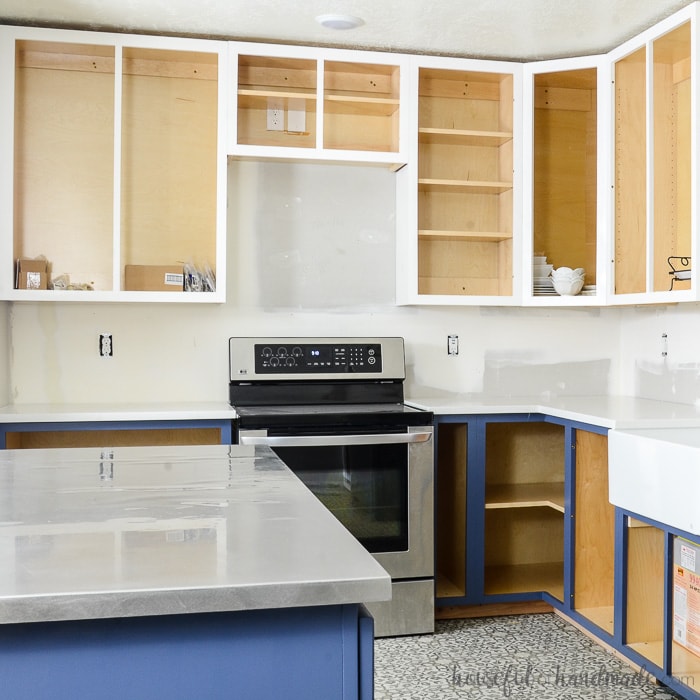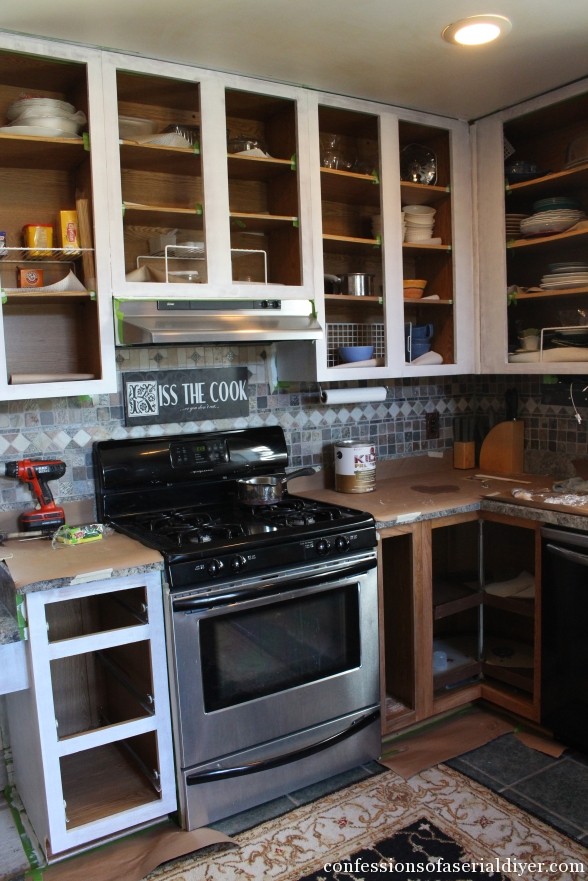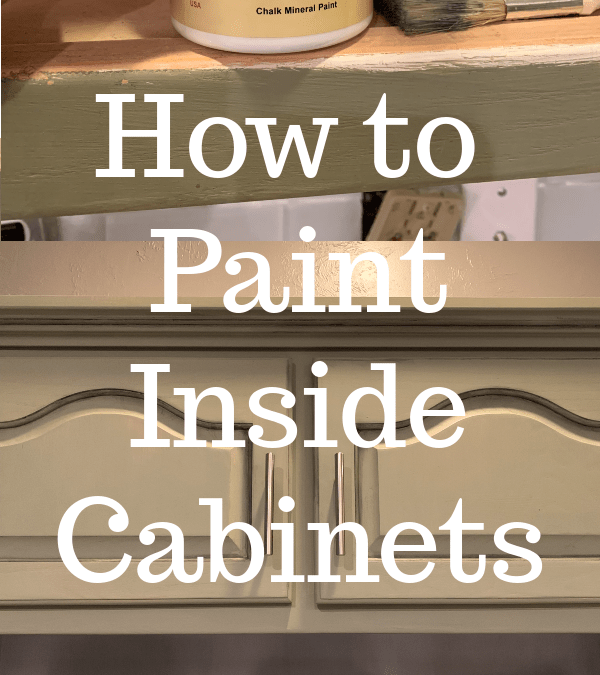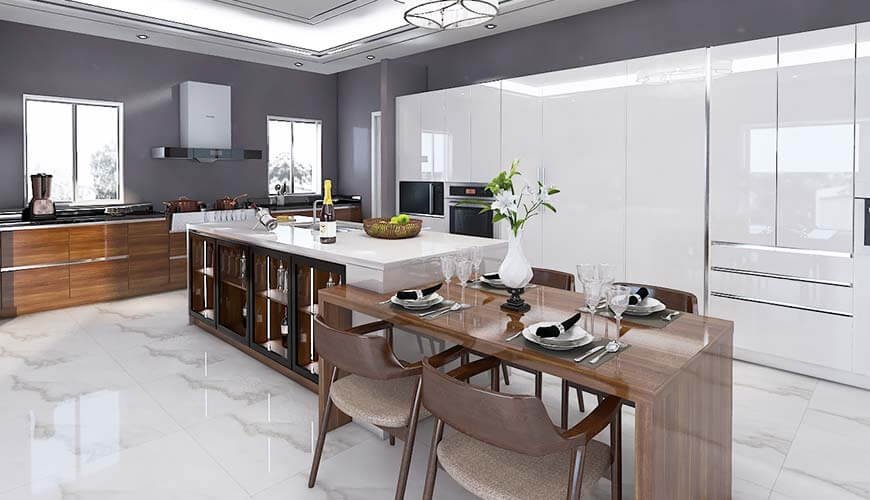Yes, you are supposed to paint the inside of kitchen cabinets. It enhances aesthetics and protects the wood.
Painting the inside of kitchen cabinets offers many benefits. It gives your kitchen a fresh and clean look. This helps in maintaining a consistent design and color scheme. Painted surfaces are easier to clean and maintain. They also provide an extra layer of protection against moisture and stains.
This can extend the life of your cabinets. A well-painted interior can also increase the value of your home. People appreciate attention to detail in kitchen spaces. Overall, painting the inside of kitchen cabinets is a practical and visually appealing choice. It makes your kitchen look complete and well-maintained.

Table of Contents
TogglePainting Kitchen Cabinets
Painting kitchen cabinets can refresh the look of your kitchen. It is a cost-effective way to give your space a new feel. But should you paint the inside of the cabinets too? Let’s explore this topic in detail.
Pros And Cons
| Pros | Cons |
|---|---|
|
|
Expert Opinions
Experts have mixed opinions on painting the inside of kitchen cabinets. Some argue it offers a polished and clean look. Others believe it is an unnecessary task.
Interior designers often suggest painting the inside if you have glass cabinet doors. This provides a cohesive appearance. On the other hand, some professional painters recommend skipping it to save time and effort.
Here are some expert tips:
- Use high-quality paint that is durable and easy to clean.
- Consider the overall design and color scheme of your kitchen.
- Ensure proper ventilation while painting to avoid fumes.
By weighing the pros and cons, you can make an informed decision. Consider the expert opinions and your personal preferences. Happy painting!

Choosing The Right Paint
Painting the inside of kitchen cabinets can refresh your kitchen. The right paint ensures longevity and a beautiful finish. Knowing the types of paint and color choices helps in decision-making.
Types Of Paint
Various paint types suit kitchen cabinets. Here’s a breakdown:
| Paint Type | Description |
|---|---|
| Latex Paint | Water-based, easy to clean, low odor. |
| Oil-Based Paint | Durable, smooth finish, longer drying time. |
| Chalk Paint | Matte finish, requires sealing, vintage look. |
Color Selection
Choosing the right color for inside your kitchen cabinets is crucial. Here are some tips:
- Light Colors: Make the space look bigger and brighter.
- Dark Colors: Add depth and a modern feel.
- Neutral Colors: Timeless and versatile, match any decor.
Consider matching the cabinet interior with the kitchen’s overall theme. This creates a harmonious look.
Preparation Steps
Thinking about painting the inside of your kitchen cabinets? It’s a great way to refresh your space. Before you start, it’s crucial to follow the right preparation steps. This ensures a smooth and lasting finish. Follow these simple steps to get your cabinets ready for painting.
Cleaning And Sanding
First, clean the surfaces. Use a mild detergent and water. Wipe down the insides of the cabinets. Remove all grease and grime. Let them dry completely.
Next, it’s time for sanding. Lightly sand the surfaces with fine-grit sandpaper. This helps the primer and paint stick better. Use a tack cloth to remove all dust. Sanding ensures a smooth base for painting.
Priming Surfaces
Now, apply a primer. Choose a high-quality primer suitable for wood. Use a brush or a roller for even coverage. Ensure all surfaces are covered.
Let the primer dry completely. Check the drying time on the primer can. Usually, it takes a few hours. Once dry, lightly sand the surface again. This helps in creating a smooth finish. Remove dust with a tack cloth.
These steps might seem tedious, but they’re worth it. Proper preparation ensures your cabinets look professional and last longer. Follow these steps for a beautiful kitchen transformation.

Tools And Materials
Painting the inside of kitchen cabinets can transform your kitchen’s look. To achieve a professional finish, you need the right tools and materials. Below, we outline the essential tools and recommended materials to make your painting project a success.
Essential Tools
You need specific tools for a smooth and even paint job. Here’s a list of the essential tools:
- Paintbrushes: A variety of sizes for different areas.
- Rollers: Small, foam rollers work best for cabinets.
- Sandpaper: Fine-grit sandpaper (220 grit) for smoothing surfaces.
- Painter’s Tape: To protect edges and create clean lines.
- Screwdriver: For removing cabinet doors and hardware.
- Drop Cloths: To protect floors and countertops from paint splatters.
Recommended Materials
Choosing the right materials is crucial for durability and appearance. Here are the recommended materials:
| Material | Purpose |
|---|---|
| Primer | Ensures better paint adhesion and durability. |
| Paint | Choose high-quality, durable paint suitable for cabinets. |
| Wood Filler | Fills in any imperfections or holes. |
| Cleaning Solution | Removes grease and dirt from cabinet surfaces. |
With the right tools and materials, painting your kitchen cabinets becomes easier. Ensure you have everything ready before starting the project. Happy painting!
Painting Techniques
Painting the inside of kitchen cabinets can transform your kitchen. The right technique ensures a smooth and durable finish. Two common methods are using a brush or a spray. Knowing which to choose and how to apply the layers is key.
Brush Vs. Spray
Choosing between a brush and spray affects the finish quality. Let’s compare both:
| Technique | Advantages | Disadvantages |
|---|---|---|
| Brush |
|
|
| Spray |
|
|
Layering And Finishing
Proper layering and finishing are essential for a lasting paint job.
- Preparation: Clean and sand the surfaces.
- Primer: Apply a primer coat. This helps paint adhere better.
- First Coat: Apply the first coat of paint. Use even strokes.
- Second Coat: Apply a second coat after the first dries.
- Finishing: Finish with a clear sealant for protection.
Follow these steps to ensure a smooth and durable finish for your kitchen cabinets.
Drying And Curing
Painting the inside of kitchen cabinets requires careful attention to the drying and curing process. This ensures a durable and long-lasting finish. Understanding these steps can help you achieve a professional look.
Drying Time
Drying time is the period it takes for the paint to become touch-dry. This can vary based on the type of paint used. Oil-based paints generally take longer to dry compared to water-based ones.
To speed up drying, ensure proper ventilation. Using fans can help circulate air and reduce humidity. Always follow the paint manufacturer’s recommended drying time.
| Paint Type | Average Drying Time |
|---|---|
| Water-based | 4-6 hours |
| Oil-based | 24 hours |
Curing Process
The curing process is crucial for paint durability. Curing involves the paint hardening completely. This process can take longer than drying.
Curing times can vary significantly. Water-based paints generally cure within 1-2 weeks. Oil-based paints can take up to a month. During this time, avoid placing items inside the cabinets.
To ensure a proper cure, maintain a stable temperature and humidity level. Avoid extreme temperature changes. This helps the paint molecules to bond properly, ensuring a strong and durable finish.
- Keep a consistent temperature.
- Monitor humidity levels.
- Avoid placing items inside too soon.
Proper drying and curing are essential steps in painting kitchen cabinets. These steps ensure a smooth and long-lasting finish.
Maintenance Tips
Maintaining your painted kitchen cabinets is essential for long-lasting beauty. Follow these simple tips to keep your cabinets looking new.
Cleaning Painted Surfaces
Regular cleaning keeps your cabinets fresh. Use a soft cloth with mild soap. Avoid abrasive cleaners; they scratch the paint. A gentle wipe-down removes stains and dust.
- Use a soft microfiber cloth.
- Mix a few drops of mild dish soap in warm water.
- Gently wipe the painted surfaces.
- Dry with a clean towel to avoid water marks.
Touch-up Advice
Minor chips and scratches happen. Touch them up to maintain a neat look. Keep the original paint color handy for easy fixes.
- Clean the area with a damp cloth.
- Use a small brush for precision.
- Apply thin layers of paint.
- Let each layer dry completely.
For larger areas, you may need to sand before painting. This ensures a smooth and even finish.
Additional Tips
| Task | Frequency |
|---|---|
| Dust Cabinets | Weekly |
| Deep Clean | Monthly |
| Touch-Up Paint | As Needed |
By following these tips, your painted kitchen cabinets will look beautiful for years. Regular maintenance is key to preserving their charm and functionality.
Common Mistakes
Painting the inside of kitchen cabinets can be tricky. Many make mistakes that spoil the finish. Avoid these common pitfalls to achieve a smooth, professional look.
Avoiding Streaks
Streaks can ruin the appearance of painted cabinets. Follow these steps to avoid streaks:
- Use a high-quality brush. Cheap brushes leave streaks.
- Apply thin coats. Thick coats lead to uneven coverage.
- Sand between coats. Light sanding smooths the surface.
- Paint in one direction. Consistent strokes prevent streaks.
Handling Drips
Drips are another common problem. They can harden and ruin the finish. Handle drips with these tips:
- Inspect your work frequently. Catch drips before they dry.
- Use painter’s tape. Tape catches excess paint.
- Brush out drips immediately. Smooth them out while wet.
- Hold the brush at an angle. Prevents excess paint buildup.
| Common Mistake | Solution |
|---|---|
| Streaks | Use a high-quality brush, apply thin coats, sand between coats, paint in one direction. |
| Drips | Inspect your work, use painter’s tape, brush out drips, hold the brush at an angle. |
Frequently Asked Questions
Should You Paint Inside Kitchen Cabinets?
Painting inside kitchen cabinets can enhance their look and cleanliness, but it’s not necessary for functionality.
What Paint Is Best For Kitchen Cabinets?
Use high-quality, durable paint like acrylic or latex enamel for a smooth, long-lasting finish inside cabinets.
Do You Need To Prime Cabinets First?
Yes, priming ensures better paint adhesion and a smoother finish, especially on previously unpainted or dark surfaces.
How To Prepare Cabinets For Painting?
Clean thoroughly, sand surfaces lightly, and apply a primer before painting to ensure a smooth, durable finish.
Can You Paint Over Varnished Cabinets?
Yes, but sand the varnish lightly and use a good primer to ensure the paint adheres properly.
How Long Does Cabinet Paint Last?
With proper preparation and quality paint, the finish can last several years without chipping or peeling.
Is It Expensive To Paint Cabinets?
Costs vary, but painting cabinets is generally cheaper than replacing them. DIY can save more money.
Do Painted Cabinets Chip Easily?
Quality paint and proper preparation reduce chipping. Using a durable topcoat can also extend the paint’s life.
What Color Is Best For Cabinet Interiors?
Light colors make it easier to see items and can make the space feel larger and cleaner.
How Long Does Cabinet Paint Take To Dry?
Typically, paint dries to the touch in 2-4 hours, but allow 24 hours for full curing.
Conclusion
Painting the inside of kitchen cabinets can enhance your space. It adds a fresh, clean look and protects surfaces. Consider your needs and style preferences. Whether you do it yourself or hire a professional, a well-painted interior elevates your kitchen’s appeal.
Make your kitchen a place you love.


